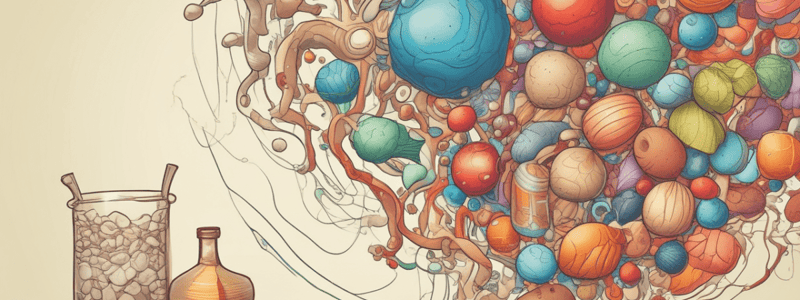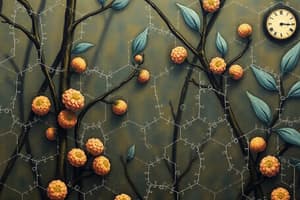Podcast
Questions and Answers
What is the primary function of carbohydrates in the human body?
What is the primary function of carbohydrates in the human body?
- To regulate body temperature
- To supply energy to the body (correct)
- To synthesize proteins
- To provide structural support to cells
What is the name of the smallest carbohydrate, which is a triose?
What is the name of the smallest carbohydrate, which is a triose?
- Glycogen
- Fructose
- Glucose
- Glyceraldehyde (correct)
Where are carbohydrates primarily stored in the body?
Where are carbohydrates primarily stored in the body?
- In the heart
- In the liver and muscle (correct)
- In the brain
- In the kidneys
What is the predominant form of sugars found in humans?
What is the predominant form of sugars found in humans?
What is the general formula for carbohydrates?
What is the general formula for carbohydrates?
What is the term for a carbohydrate with a terminal carbonyl group?
What is the term for a carbohydrate with a terminal carbonyl group?
What is the functional group present in carbohydrates?
What is the functional group present in carbohydrates?
What is the number of carbon atoms in a pentose?
What is the number of carbon atoms in a pentose?
What is the term for a carbohydrate with three carbon atoms?
What is the term for a carbohydrate with three carbon atoms?
Which carbohydrate has six carbon atoms?
Which carbohydrate has six carbon atoms?
What is the name of the carbohydrate with the fewest carbon atoms?
What is the name of the carbohydrate with the fewest carbon atoms?
How many carbon atoms are present in a tetrose?
How many carbon atoms are present in a tetrose?
What is the process by which glucose molecules are converted to pyruvate or lactate for energy production?
What is the process by which glucose molecules are converted to pyruvate or lactate for energy production?
Which process involves the formation of glucose-6-phosphate from non-carbohydrate sources?
Which process involves the formation of glucose-6-phosphate from non-carbohydrate sources?
What is the breakdown of glycogen to glucose for use as energy called?
What is the breakdown of glycogen to glucose for use as energy called?
What is the conversion of glucose to glycogen for storage called?
What is the conversion of glucose to glycogen for storage called?
What is the decomposition of fat called?
What is the decomposition of fat called?
What is the byproduct of glucose conversion in the presence of insulin via the EMP pathway?
What is the byproduct of glucose conversion in the presence of insulin via the EMP pathway?
What is the product of glycolysis in the EMP pathway?
What is the product of glycolysis in the EMP pathway?
What is the process of synthesizing glucose from amino acids, glycerol, lactate, and pyruvate called?
What is the process of synthesizing glucose from amino acids, glycerol, lactate, and pyruvate called?
What is the process of converting glycogen to glucose in the liver called?
What is the process of converting glycogen to glucose in the liver called?
What is the process of converting excess glycogen into fat called?
What is the process of converting excess glycogen into fat called?
What is the breakdown of triglycerides with the formation of ketone bodies called?
What is the breakdown of triglycerides with the formation of ketone bodies called?
What is the primary function of insulin in the body?
What is the primary function of insulin in the body?
What is the result of high sugar levels in the blood?
What is the result of high sugar levels in the blood?
Which hormone is responsible for increasing plasma glucose?
Which hormone is responsible for increasing plasma glucose?
What happens to glucose when it is absorbed by the small intestine?
What happens to glucose when it is absorbed by the small intestine?
Which part of the pancreas produces insulin?
Which part of the pancreas produces insulin?
What is the function of epinephrine in response to stress?
What is the function of epinephrine in response to stress?
Where are the chromatin cells that secrete epinephrine located?
Where are the chromatin cells that secrete epinephrine located?
What triggers the release of epinephrine?
What triggers the release of epinephrine?
What is the location of the adrenal glands?
What is the location of the adrenal glands?
What is the classification of epinephrine?
What is the classification of epinephrine?
Where is cortisol produced in the body?
Where is cortisol produced in the body?
What is the process by which cortisol provides the body with glucose during stressful conditions?
What is the process by which cortisol provides the body with glucose during stressful conditions?
Which type of cells in the zona fasciculata release cortisol?
Which type of cells in the zona fasciculata release cortisol?
What is the source of glucose that cortisol taps into during stressful conditions?
What is the source of glucose that cortisol taps into during stressful conditions?
In which organ does cortisol stimulate the process of gluconeogenesis?
In which organ does cortisol stimulate the process of gluconeogenesis?
What gland is responsible for secreting growth hormone?
What gland is responsible for secreting growth hormone?
What is the resulting hormone when three iodine atoms are bound to thyroglobulin?
What is the resulting hormone when three iodine atoms are bound to thyroglobulin?
What is the effect of somatostatin on plasma glucose levels?
What is the effect of somatostatin on plasma glucose levels?
Where are the D-cells located in the pancreas?
Where are the D-cells located in the pancreas?
What is the precursor molecule that is iodinated to form thyroxine?
What is the precursor molecule that is iodinated to form thyroxine?
Flashcards are hidden until you start studying




